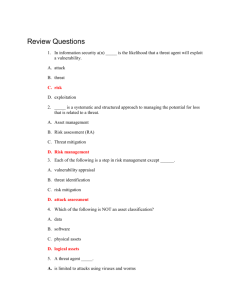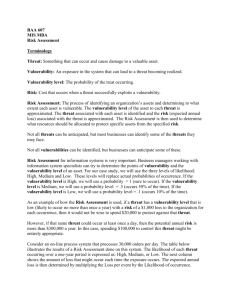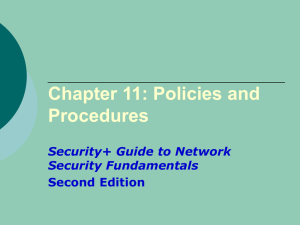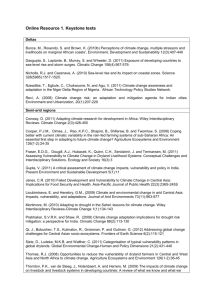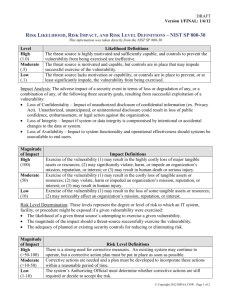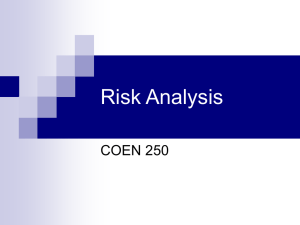Chapter 4
advertisement
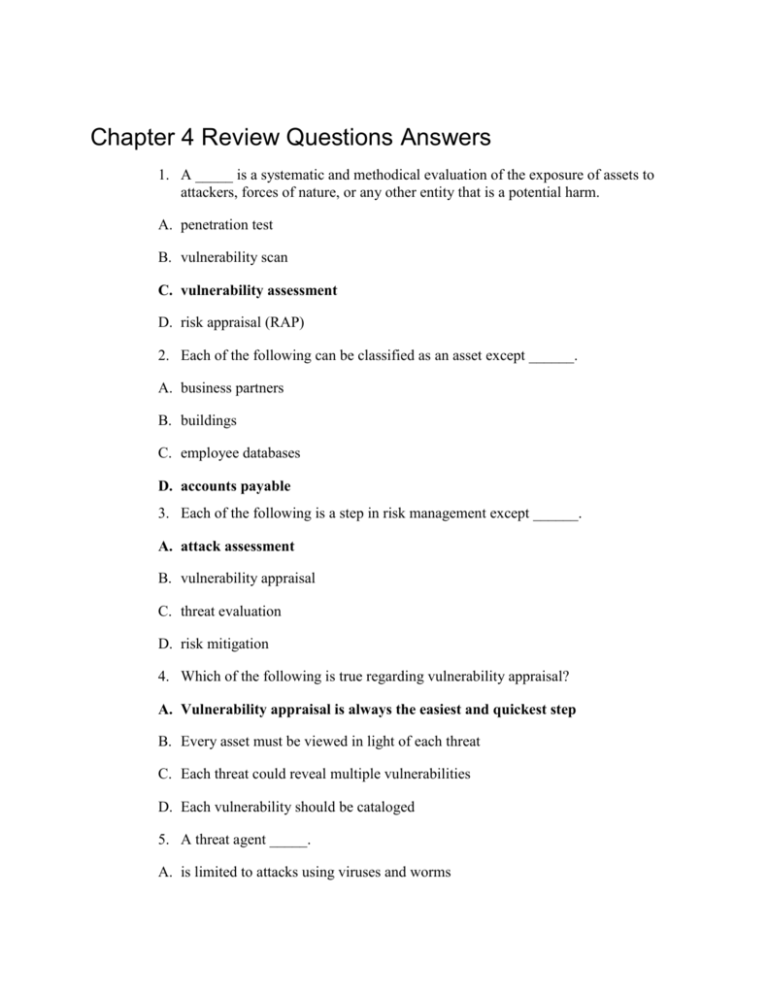
Chapter 4 Review Questions Answers 1. A _____ is a systematic and methodical evaluation of the exposure of assets to attackers, forces of nature, or any other entity that is a potential harm. A. penetration test B. vulnerability scan C. vulnerability assessment D. risk appraisal (RAP) 2. Each of the following can be classified as an asset except ______. A. business partners B. buildings C. employee databases D. accounts payable 3. Each of the following is a step in risk management except ______. A. attack assessment B. vulnerability appraisal C. threat evaluation D. risk mitigation 4. Which of the following is true regarding vulnerability appraisal? A. Vulnerability appraisal is always the easiest and quickest step B. Every asset must be viewed in light of each threat C. Each threat could reveal multiple vulnerabilities D. Each vulnerability should be cataloged 5. A threat agent _____. A. is limited to attacks using viruses and worms B. does not include natural disasters C. is something that cannot be determined in advance D. is a person or entity with the power to carry out a threat against an asset 6. _____ constructs scenarios of the types of threats that assets can face in order to learn who the attackers are, why they attack, and what types of attacks may occur. A. Vulnerability prototyping B. Risk assessment C. Attack assessment D. Threat modeling 7. What is a current snapshot of the security of an organization? A. Vulnerability appraisal B. Risk evaluation C. Threat mitigation D. Liability reporting 8. The _____ is the proportion of an asset’s value that is likely to be destroyed by a particular risk. A. Exposure Factor (EF) B. Single Loss Expectancy (SLE) C. Annualized Rate of Occurrence (ARO) D. Annualized Loss Expectancy (ALE) 9. Which of the following is NOT an option for dealing with risk? A. Eliminate the risk B. Accept the risk C. Diminish the risk D. Transfer the risk 10. ________ is a comparison of the present security state of a system compared to a standard established by the organization. A. Risk mitigation B. Baseline reporting C. Comparative Resource Appraisal (CRA) D. Horizontal comparables 11. Each of the following is a state of a port that can be returned by a port scanner except _____. A. open B. busy C. blocked D. closed 12. Each of the following is true regarding TCP SYN port scanning except ______. A. it uses FIN messages that can pass through firewalls and avoid detection B. instead of using the operating system's network functions, the port scanner generates IP packets itself and monitors for responses C. the scanner host closes the connection before the handshake is completed D. this scan type is also known as “half-open scanning” because it never actually opens a full TCP connection 13. The protocol File Transfer Protocol (FTP) uses which two ports? A. 19 and 20 B. 20 and 21 C. 21 and 22 D. 22 and 23 14. A protocol analyzer places the computer’s network interface card (NIC) adapter into _____ mode. A. promiscuous B. full C. view D. real 15. Each of the following is a function of a vulnerability scanner except ______. A. detect which ports are served and which ports are browsed for each individual system B. alert users when a new patch cannot be found C. maintain a log of all interactive network sessions D. detect when an application is compromised 16. Which of the following is true of the Open Vulnerability and Assessment Language (OVAL)? A. It only functions on Linux-based computers. B. It attempts to standardize vulnerability assessments. C. It has been replaced by XML. D. It is a European standard and is not used in the Americas. 17. Which of the following is not true regarding a honeypot? A. It is typically located in an area with limited security. B. It contains real data files because attackers can easily identify fake files. C. It cannot be part of a honeynet. D. It can direct an attacker’s attention away from legitimate servers. 18. Which of the following is true of vulnerability scanning? A. It uses automated software to scan for vulnerabilities. B. The testers are always outside of the security perimeter. C. It may disrupt the operation of the network or systems. D. It produces a short report of the attack methods and value of the exploited data. 19. If a tester is given the IP addresses, network diagrams, and source code of customer applications, then she is using which technique? A. Black box B. White box C. Gray box D. Blue box 20. If a software application aborts and leaves the program open, which control structure is it using? A. Fail-safe B. Fail-secure C. Fail-open D. Fail-right
